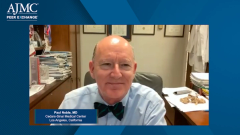
Treatment Goals for Patients With ILD
Drs Noble and Highland explain the typical treatment goals physicians aim for when looking at ILD therapy options.
Episodes in this series

Ryan Haumschild, PharmD, MS, MBA: I’d like to transition to speak more about treatment and management. I know we’ve touched on this a little in the background of the disease, but I think it’s important for us to discuss the treatment paradigms, and what are the standard of care therapies for interstitial lung disease [ILD]. I want to start off with Dr Noble, if you could chime in on what are the goals of treatment for idiopathic pulmonary fibrosis [IPF], progressive fibrosing interstitial lung disease, and systemic sclerotic interstitial lung disease. What are the goals of treatment that you’re looking for, and what are you treating those patients with? If you could get us started.
Paul Noble, MD: My pleasure. My goal is always to prevent my patient from dying or needing a lung transplant. That’s why I say I’m kind of losing the game when that happens. Up front what’s key is making the decision, is this lung disease part of a systemic process, or is this really just the lung that’s involved? Distinguishing chronic HP [hypersensitivity pneumonitis] and connective tissue disease [CTD]-related fibrosing lung disease from IPF is essential because if it’s one of the former, you’re going to want to treat the underlying cause. What that means is getting rid of an inciting agent, but more importantly it means targeting the immune system. We believe both chronic HP and CTD-related ILD are immune-driven processes, so [we give] steroids and a steroid-sparing agent. My favorite is mycophenolate. We can oftentimes prevent progression and sometimes, not as often as we’d like, we can see major improvement and patients can be in “remission” for many years. I’ve had patients I’ve followed for upward of 20 years who’ve had a stable connective tissue disease and never gone on to need a lung transplant. That’s really critical. That’s one of my biggest concerns of community practitioners, where certainly with the progressive phenotype, the argument from some of the pharmaceutical companies is [to] just put everybody in on an antifibrotic treatment. My concern with that is if you miss the underlying cause, you’re keeping that patient from the opportunity of getting better because the antifibrotics don’t make you better. They slow the loss of lung function, but nobody really gets better in that sense.
So early diagnosis, determining whether you’re going to target the immune system, and then if you do think it’s IPF, it is important then to consider an antifibrotic. It’s a really interesting conversation, particularly in early stages of the disease because as I’m sure we’ll talk about, there are tolerability issues with these medications. I had the good fortune to be involved with both nintedanib and pirfenidone from the very beginning for the IPF trials, and it’s very clear that they slow the loss of lung function.
Ryan Haumschild, PharmD, MS, MBA: When you look at goals of treatment, I think you explained it well, you really want to manage the patient. You want to decrease inflammation, prevent any of the formation or the progression of lung scarring, and also try to remove the source of the problem. I think that’s another thing you worked out, that differential diagnosis of what is the true source, and how can we improve the quality of life for the patient? How do we minimize or manage any potential complications of disease progression? Then lastly, we want to decrease that deterioration of a patient’s quality of life because we know when patients have better quality of life, they function, they have higher motivation for therapy. I think Dr Highland hit on that in our previous conversation.
This transcript has been edited for clarity.
Newsletter
Stay ahead of policy, cost, and value—subscribe to AJMC for expert insights at the intersection of clinical care and health economics.






























































